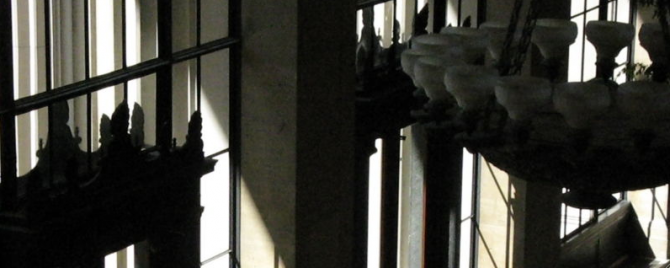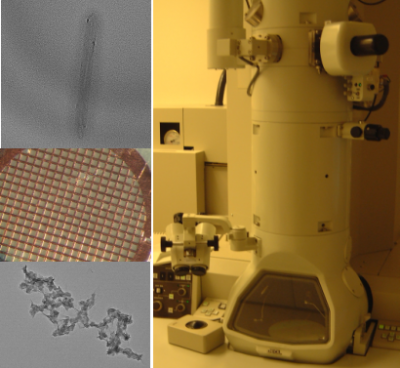Difference between revisions of "20.109(F07):Module 3"
MAXINE JONAS (Talk | contribs) m (13 revisions: Transfer 20.109(F07) to HostGator) |
|||
| (5 intermediate revisions by one user not shown) | |||
| Line 5: | Line 5: | ||
==Module 3== | ==Module 3== | ||
| − | '''Instructors:''' [ | + | '''Instructors:''' [http://openwetware.org/wiki/User:Abelcher | Angela Belcher], [http://openwetware.org/wiki/Natalie_Kuldell ] and [http://openwetware.org/wiki/User:AgiStachowiak | Agi Stachowiak] |
| − | '''TA:'''[ | + | '''TA:'''[http://openwetware.org/wiki/User:Barbero |Robbie Barbero] |
| − | + | ���Invention��� is a wonderful word, derived from words meaning ���scheme��� and ���a finding out.��� Inventors draw on materials provided by the natural world, refining and combining them in insightful ways, to make something useful. In this experimental module we will invent materials by manipulating biological systems, namely the bacteriophage M13. We will use a very slightly modified phage to build Iridium nanowires that we���ll visualize on the transmission electron microscope. Then we'll let the phage themselves do the building, making an electrochromic device that's both fun and potentially useful. Drawing on the rich stockroom of biological elements and a good but incomplete understanding of their behavior, we���ll hope to invent some novel materials with real-world applications. | |
| − | + | ||
[[Image:Macintosh HD-Users-nkuldell-Desktop-Mod4 coverartS07.png|thumb|400px|center| TEM of M13E4 after CoCl2/NaBH4 treatment, image by Natalie Kuldell, Anthony Garratt-Reed and KiTae Nam]] | [[Image:Macintosh HD-Users-nkuldell-Desktop-Mod4 coverartS07.png|thumb|400px|center| TEM of M13E4 after CoCl2/NaBH4 treatment, image by Natalie Kuldell, Anthony Garratt-Reed and KiTae Nam]] | ||
[[20.109(F07): Growth of phage materials| Module 3 Day 1: growth of phage materials]] <br> | [[20.109(F07): Growth of phage materials| Module 3 Day 1: growth of phage materials]] <br> | ||
| − | [ | + | [http://openwetware.org/wiki/20.109(F07):_Phage_nanowires | Module 3 Day 2: making nanowires]<br> |
[[20.109(F07): Transmission electron microscopy| Module 3 Day 3: TEM]]<br> | [[20.109(F07): Transmission electron microscopy| Module 3 Day 3: TEM]]<br> | ||
[[20.109 (F07): Phage by design| Module 3 Day 4: Phage by design]] <br> | [[20.109 (F07): Phage by design| Module 3 Day 4: Phage by design]] <br> | ||
| − | [[20.109 ( | + | [[20.109(F07): Phage by design, pt2 | Module 3 Day 5: Phage by design, pt 2 ]]<br> |
| − | [[20.109 ( | + | [[20.109(F07): ECD assembly| Module 3 Day 6: ECD assembly]]<br> |
| − | [[20.109(F07): Module 3 oral presentations| Module 3 Day | + | [[20.109(F07): Module 3 oral presentations| Module 3 Day 7: oral presentations]]<br> |
direct link to [[20.109(F07): ECD experimental variations| experimental variations]] page | direct link to [[20.109(F07): ECD experimental variations| experimental variations]] page | ||
| − | [ | + | [http://openwetware.org/wiki/20.109(F07):_TA's_notes_for_module_3 | TA notes, mod 3] |
Latest revision as of 15:54, 15 June 2015
Module 3
Instructors: | Angela Belcher, [1] and | Agi Stachowiak
���Invention��� is a wonderful word, derived from words meaning ���scheme��� and ���a finding out.��� Inventors draw on materials provided by the natural world, refining and combining them in insightful ways, to make something useful. In this experimental module we will invent materials by manipulating biological systems, namely the bacteriophage M13. We will use a very slightly modified phage to build Iridium nanowires that we���ll visualize on the transmission electron microscope. Then we'll let the phage themselves do the building, making an electrochromic device that's both fun and potentially useful. Drawing on the rich stockroom of biological elements and a good but incomplete understanding of their behavior, we���ll hope to invent some novel materials with real-world applications.
Module 3 Day 1: growth of phage materials
| Module 3 Day 2: making nanowires
Module 3 Day 3: TEM
Module 3 Day 4: Phage by design
Module 3 Day 5: Phage by design, pt 2
Module 3 Day 6: ECD assembly
Module 3 Day 7: oral presentations
direct link to experimental variations page

